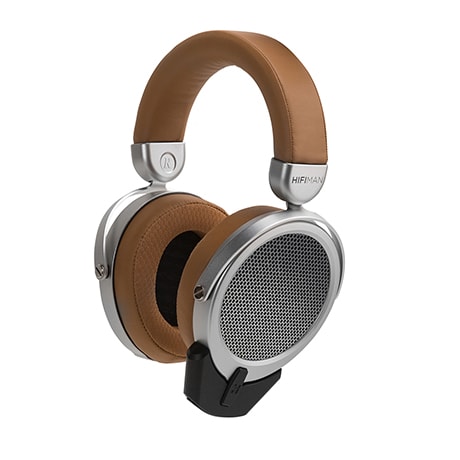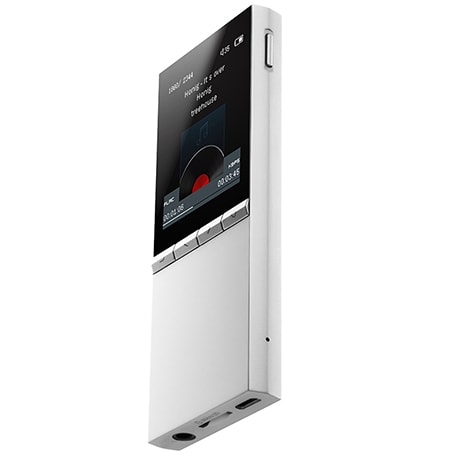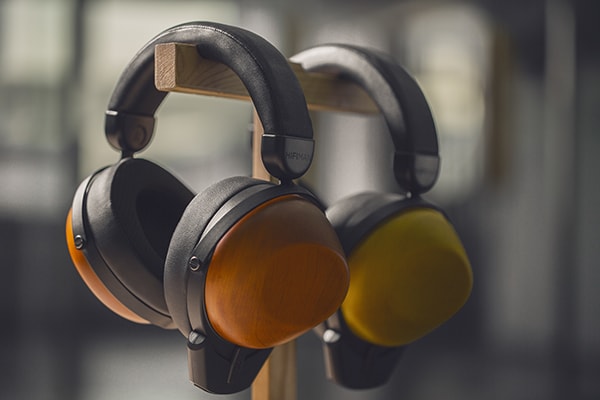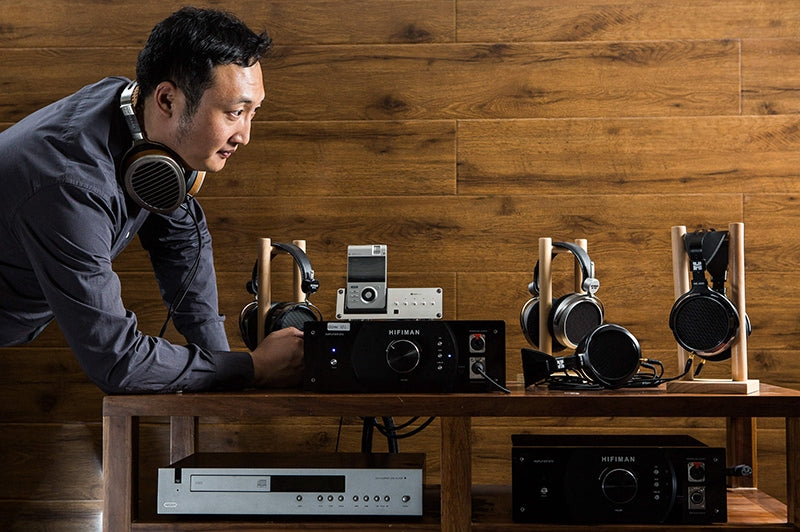HIFIMAN manufactures high-end headphones, headphone amps, portable music players, headphone cables, and other products. The company was founded in by Dr. Fang Bian in 2007 in China and, two years later, introduced the HM-801, the first portable digital audio player to feature high-performance sound from a pocket-size form factor. Since then, HIFIMAN has developed an extensive selection of rave-reviewed audio components and products that have earned the company world-class status among audiophiles.
John Seetoo: Growing up in China, did you come from a family where music was important? What kind of music did you listen to growing up, and do you still reference that music when testing your latest HIFIMAN products?
Dr. Fang Bian: I grew up in a family of medical doctors who worked for a huge coal mine plant. My parents don’t listen to music, but there were some speakers in the playground in the primary school [I attended] that played music in the background when we did our morning exercises, and they also played classical music in the afternoon. This was the beginning of my interest in music.
In my middle school years, I got my first cassette Walkman. Immediately, I started listening to light music in middle school, and rock and roll in high school. I still reference both Dire Straits and Richard Wagner when I test our products.

JS: You have stated in other interviews that your interest in personal audio began with listening to a Walkman at age 10. At what point did you realize the wide range of sound quality available from different headphones, and what were your favorite models to listen with before forming your own company and building your own designs? Are there any elements from those favorite models that show up in HIFIMAN products, including your entry-level DEVA model?
FB: In the 1980s and 1990s, the average income in China was only $50 – $200USD per month, so the Walkman was considered an expensive product. Around this time, I started collecting relatively inexpensive earbuds to improve the sound quality of my portable music system.
I noticed that every model of earbud sounded different, and [that] more expensive models didn’t [necessarily] sound better than cheaper options. Some Sony earbuds like the ’80s MDR-E252 model sounded very good, but later models didn’t measure up to the same quality.
Later, in the ’90s, the HD580 and HD565 from Sennheiser marked a real improvement in personal audio. All of these products gave me a clear idea of how to achieve the best sound from an audio product. However, it was the Boston Symphony Orchestra and venues like Lincoln Center and Carnegie Hall that inspired the direction of our current sound signature.

JS: What were the design and manufacturing hurdles when you started your company with the HE5, a high-end planar headphone, as your first product? Why did you decide to design planar magnetic headphones? What led you to choose wood for the ear cups, and what properties among different woods determined your final choice?
FB: The first HIFIMAN product was [actually] an in-ear earphone called the RE2. To be clear, I didn’t design the HE5. HIFIMAN’s co-founder Mr. He is responsible for introducing planar and electrostatic technology to HIFIMAN’s engineering team.
Initially, we focused on the development of the Jade electrostatic headphones. Later on, [but still in our] earlier years at HIFIMAN, we noticed that electrostatic designs were not practical commercial concepts without [having the benefit of] a dedicated engineering team and lab. Planar, on the other hand, sounds great and is easier to manufacture and sell at reasonable prices.
We chose wood because it produces impressive midrange frequencies, and wood parts don’t require expensive tooling.
JS: HIFIMAN’s HM Series of portable high-resolution music players have become a breakthrough device that have succeeded where products with higher profiles, such as Neil Young’s Pono, failed. Why do you think HIFIMAN’s HM portable players have been more widely accepted? Also, can you explain how the Minibox, balanced, and your other swappable amplifier cards work?

FB: We were the first manufacturer to bring high-fidelity portable players to market. HIFIMAN products include an audiophile-grade DAC and a sophisticated headphone amplifier in a portable device.
Given that there are so many different headphones on the market, we designed [our[ amplifier module as a standard [configuration that could be tailored using interchangeable plug-in amplifier cards], so that people can easily change amplifier settings to accommodate nearly every [type of] headphones, including high- and low-impedance models, IEMs (in-ear monitors], and so on.
JS: The HIFIMAN EF-6 headphone amplifier was your flagship headphone amplifier and could also serve as a preamp. You have since discontinued it, as well as several tube amps. In what ways was the EF-6 being used as a preamp and will HIFIMAN be coming out with an improved version of it or other tube amps in the future? Are the Shangri-La, Shangri-La Jr. models and Jade II electrostatic headphone/amplifier packages the only high-end amp systems currently being offered?
 Shangri-La Jr. electrostatic headphones and amplifier.
Shangri-La Jr. electrostatic headphones and amplifier.FB: We just released the EF6se in China last month. We plan to release it in the West later this year. The EF6se features a significantly improved volume control and overall cosmetics.
JS: You have mentioned in the past that you are very sensitive to cable quality for HIFIMAN headphones and use high-quality “crystalline” silver and copper cables of a proprietary nature. In what areas of the audio spectrum and in what examples of music did you notice a significant enough difference to convince you to use crystalline silver and copper over other types of cables?
FB: Silver has a totally “V-shaped” sound signature [EQ curve], but copper gives better midrange response. However, the sound signature changes significantly according to the structural design changes [of the cable construction].
JS: I was able to audition the Shangri-La, Susvara and Deva models at the 2020 New York CanJam headphones show and was floored by all three. However, although the differences were more readily apparent when listening to acoustic or orchestral music, I was amazed that the $299 Deva came very close to the $6,000 Susvara when listening to rock and R&B music, especially via Bluetooth. What percentage of the Deva headphones’ full audio range can be heard through Bluetooth vs. through a USB-C or its 3.5mm plug cable? This question is about Fang Bian’s personal opinion, not the listed specs.
 Sundara headphones, exploded diagram.
Sundara headphones, exploded diagram.FB: The USB input always gives better detail than Bluetooth, because Bluetooth [offers] much less bandwidth than USB. But a 3.5mm cable [also] gives Deva the flexibility to be driven by different headphone amps. Some well-designed headphone amps will get more out of Deva, but its built-in amp beats a lot of the outboard amps on the market.
JS: You have mentioned that Dire Straits’ Alchemy is your favorite record. As that is a live recording, is the reproduction of a live concert hall experience, which you have stated is the goal of HIFIMAN headphone design, your main benchmark for critical testing? What other live recordings would you use to audition a random headphone model from the HIFIMAN assembly line, and why? Which studio recordings, if any, and why?
FB: I like the analogue version of Alchemy very much. But the digital version sounds too bright. I’d rather listen to “Sultans of Swing” (from the Dire Straits album) when I need to do critical testing. Also, Supertramp’s albums are recorded extremely well.
When listening to classical music, I like The Ring Without Words performed by the Berlin Philharmonic.
 HE-R10D headphones.
HE-R10D headphones.Other favorites include L’Chaim (To Life): The Ultimate Jewish Music Collection. And, for critical listening of female vocals, I’m a big fan of Jennifer Warnes, Esther Ofarim, Ayako Hosokawa, and many others.
JS: Your selection of HIFIMAN IEMs appear to all be designed with dynamic drivers rather than balanced armature designs. Nelson Tackett of HEAR Technologies shares that preference, citing that balanced armature technology has too many moving parts to properly reproduce each frequency range, and is more prone to malfunction. Why does HIFIMAN primarily use dynamic driver technology in its IEMs? Also, are there any plans to design an IEM for the professional performing musician in the future?
FB: The HIFIMAN team developed a powerful technology called “Topology Diaphragm,” that allows us to make great-sounding, ultra-small dynamic drivers. [Topology Diaphragm technology involves coating the diaphragm with nanoparticles that are distributed in distinct geometric patterns. By varying the patterns and the compound and its thickness, the audio performance of the diaphragm can be controlled. – Ed.] We prefer dynamic drivers over armature designs because dynamic drivers sound more lifelike and authentic [compared] to other options.
For now, there aren’t plans to design products for the pro market. Perhaps we will take a closer look at the pro market at another time.
JS: The HIFIMAN website also offers dynamic headphones. Is this to meet a market need or a price point, or do you just want to offer different sonic flavors to listeners?
FB: We applied our Topology Diaphragm technology to full-size headphones with great results; that’s the HE-R10D closed-back headphone. It sounds great and compares well to our planar models at similar prices.
JS: The X100 Desktop Audio System is the only HIFIMAN product that uses speakers. (The X100 includes two speakers, a subwoofer and a power amplifier.) Are there any plans for HIFIMAN speakers in the future?

On another note, what components comprise Fang Bian’s personal hi-fi system and would any of those elements play a part in the design of a HIFIMAN speaker?
FB: The X100 is a good [first] speaker product [for us]. I currently use TAD Laboratories’ Compact Reference One [loudspeakers], and some hand-built speakers from our team. But we are not yet prepared to bring our speakers to market.
JS: What are some other things that you think set HIFIMAN apart from other manufacturers?
FB: Our mission is to create great-sounding products that stand out and have the potential to change the game. We are not interested in repeating ourselves for the sake of increasing sales.
JS: How has the pandemic affected HIFIMAN’s business and its customers? Have any products in particular become more in demand, and has manufacturing become affected due to sourcing components from China?
FB: The demand for full-size headphones increased during the pandemic because people stayed at home and needed to listen to music, but without intruding on others in the household.
So far, our business is unaffected by a trade war, but shipping fees and the prices of chips are becoming problems.
JS: What other product areas or plans are in store for HIFIMAN going forward?
FB: We will continue to concentrate on personal audio and will make further inroads in the headphones-for-business category in the near future.
 HE400se headphones.
HE400se headphones.



